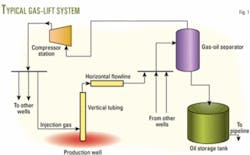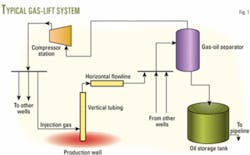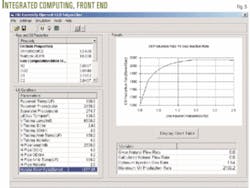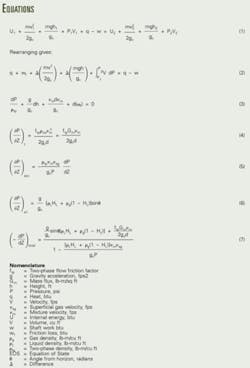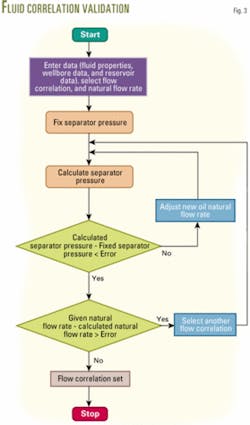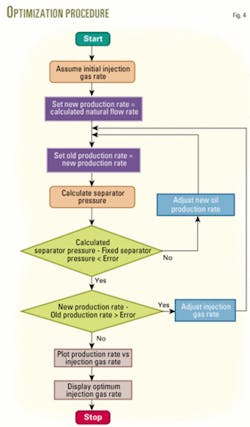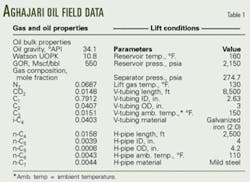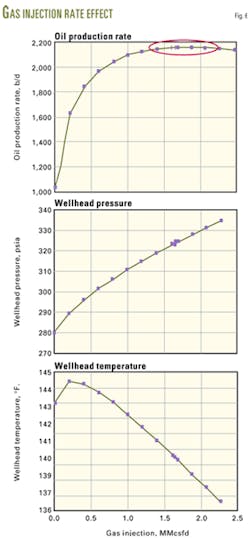Compositional model optimizes gas lift
A simulation with a compositional model, composed of a graphical front end and readily available commercial simulator software, improved the optimization of gas lift in oil wells when compared with commercial software that rely on black oil models.
The basic task for finding the optimal gas injection volume requires the calculation of production rates as a function of gas injection rate.
Because HYSYS1 is the only commercially available simulator designed for complete user customization; this analysis uses it in conjunction with Visual Basic programming to develop an integrated simulation environment for gas-lift optimization.
Besides a rigorous thermodynamic and physical property evaluation, this analysis employs a new approach for obtaining the optimum GOR.
The analysis includes field data from the giant Aghajari oil reservoir in southern Iran to illustrate the benefits of the optimization.
Gas-lift models
Artificial lift with gas lift lowers the flowing fluid density by injecting compressed gas through downhole valves placed along the production tubing.
Initially, the injected gas increases the oil production rate as the flowing gradient decreases. But with an increasing gas rate, the incremental liquid production rate per unit of injected gas diminishes until it reaches a point at which oil production declines.
Fig. 1 shows a typical gas-lift system.
The literature contains different procedures for obtaining the optimum gas injection rate.2-15 Brown discussed one widely used method.14 His procedure used gradient curves and other empirical correlations for the two-phase pressure drop in vertical and horizontal flow. In actual practice, length and size of the vertical and horizontal flowlines along with the separator pressure influence the optimization procedure. The present analysis, therefore, considers the pressure gradient in the whole system.
Previous work employs pressure-volume-temperature (PVT) data predictions based on a black-oil framework. Subsequent optimization studies have included equation of state flash calculations to model flow through separators.8
The present study expands the use of compositional modeling throughout the system components. Standard black-oil models assume the chemical composition is constant throughout a simulation. In reality, the composition may vary along a flowline because of slip effects (velocity differences between phases), interfacial mass transfer, merging networks with different fluids, and changes in fluid composition at the inlet.
Compositional multiphase-flow models predict more accurately fluid behavior. These simulators treat oil and gas phases as multicomponent mixtures and track the composition of the individual phases with equations of state that describe phase equilibrium and mass conservation.
Fig. 5 shows the front-end screen of the developed integrated computing environment.
Aghajari field
Oil production operations in Aghajari oil field in southern Iran are mature.2 Initially discovered in 1938, cumulative recovery to date from this giant 15-billion bbl oil field is about 10 billion bbl. Peak production was 1 million bo/d in 1974 after which the field produced a steady 850,000 bo/d for 17 consecutive years. The current production plans include using 3 bcfd of gas from South Pars to support a 187,000 bo/d production rate from Aghajari.
This field has 165 wells, of which 60 are on gas lift. The typical well completion includes 31/2 and 41/2-in. tubing in 95/8-in. production casing.
Multiphase flow
Proper design of well completions and artificial-lift systems requires a reliable and accurate method for predicting pressure drop in vertical multiphase flow.
HYSYS software incorporates industry-standard multiphase-flow correlations such as Beggs and Brill, Hagedorn and Brown, and OLGAS.14 15 A multiphase-flow correlation calculates, besides pressure gradients, liquid holdup and the flow pattern at a specific cross-section of a pipe. ID, roughness, and pipe inclination define the pipe cross-section.
Several factors influence the applicability of the multiphase flow models. These factors include tubing size or diameter, oil gravity, GOR, and two-phase flow with or without a water cut.
Fig. 2 illustrates the energy balance between two points of fluid flow (Equation 1 in the equation box).14
After rearrangement of the equation, Equation 1 becomes Equation 2 for two-phase flow.
Equation 3 shows the pressure drop due to friction loss, acceleration loss, and elevation change through the piping system. Equation 4, therefore, calculates the overall pressure drop.
PVT data predictions
Accurate modeling of petroleum fluid behavior with a compositional model requires an equation of state. An equation of state solution provides physical properties and phase compositions at given temperatures, pressures, and mixture compositions.
The model solves mass equations for each component in the gas phase, in the droplets and in the bulk of the oil and water phases. Hence, the compositional model will keep track of the changes in composition along the flow path and ensure a more accurate fluid description compared to a standard black-oil modal.
For modeling oil behavior, black-oil methods require a limited set of data that includes pressure, temperature, oil specific gravity, gas specific gravity, GOR, and water cut. Whereas composition models also require gas composition.
Validation procedure
The proposed algorithm for optimizing gas lift uses a heuristic search method. It starts with some current solution, explores all solutions in some neighborhood of that point looking for a better one, and repeats the calculation if an improved point is found. Fig. 3 shows the steps for validating a flow correlation and calculating the natural flow rate. The steps are as follows:
1. User enters fluid properties, wellbore data, and reservoir data; selects an appropriate flow correlation; and then enters the natural flow rate.
2. The next entry is a fixed separator pressure.
3. The simulator calculates a separator pressure for a given natural flow rate.
4. If the calculated separator pressure minus the fixed separator pressure is less than the allowed error than the calculation jumps to Step 6, otherwise it continues with Step 5.
5. The model sets the natural flow rate equal to the calculated flow rate and repeats Step 3.
6. If the calculated natural flow rate is in the proximity of given natural flow rate the calculation proceeds to Step 7, otherwise the user needs to select another correlation and the calculation returns to Step 3.
7. This last step indicates that the selected correlation is appropriate for the model
Optimization procedure
Fig. 4 shows the optimization procedure as follows:
1. Assume an initial injection gas rate.
2. Set the new production rate equal to the calculated natural flow rate.
3. Set old production rate equal to new production rate.
4. Calculate the separator pressure with the set production rate.
5. If the calculated separator pressure minus fixed separator pressure is less than the allowed error, go to Step 7, otherwise go to Step 6.
6. Check if the new production rate is less than the old production rate. If yes, go to Step 8, otherwise adjust the injection gas rate and repeat Step 3.
7. Adjust new oil production rate, repeat Step 3.
8. Plot production rate vs. injection gas rate and display the optimum injection gas rate and maximum oil production possible.
Results
Table 1 provides the Aghajari oil field data for the base case illustration. A compositional model that employs the Peng-Robinson equation of state predicted the fluid properties.
Algorithm used for the validation of multiphase flow correlation showed that for this particular case OLGAS was best at predicting the pressure drop through the system. Fig. 6a shows initial gas injection significantly increases the production rate and then an optimum gas rate is reached after which an increase in gas injection results in a decrease of oil production rate.
Table 2 provides the results from the optimization and Figs. 6a and 6b illustrate the wellhead pressure and temperature variations with respect to gas injection rate.
Figs. 7a and 7b show the expected temperature and pressure gradients.
The analysis showed that a minimum gas injection rate of 1.64 MMscfd provided a 2,158.2 bo/d production rate and that further increases in injection gas rate decreased oil production.
References
1. HYSYS User's Guide v3.0, Hyprotech Ltd., Calgary, 2002.
2. Ayatollahi, S., Narimani, M., and Moshfeghian, M., "Intermittent Gas-Lift in Aghajari Oil Field, a Mathematical Study," Journal of Petroleum Science and Engineering, Vol. 42, No. 2-4, 2004, pp. 245-55.
3. Ayatollahi, S., Bahadori, A., and Moshfeghian, M., "Simulation and Optimization of Continuous Gas Lift," JPT, May 2002, p. 60.
4. Ayatollahi, S., Bahadori, A., and Moshfeghian, M., "Method optimizes Aghajari oil field gas lift," OGJ, May 21, 2001, p. 47.
5. Bahadori, A., Ayatollahi, S., and Moshfeghian, M., "Simulation and Optimization of Continuous Gas Lift System in Aghajari Oil Field," SPE Asia Pacific Improved Oil Recovery Conference, Kuala Lumpur, Oct. 8-9, 2001.
7. Liu Yonghui, et al., "A Method to Calculate The Gas-Lift System Efficiency," SPE International Thermal Operations and Heavy Oil Symposium and Western Regional Meeting, Bakersfield, Calif., Mar. 16-18, 2004.
8. Satisburg, P.E., and Peden, J.M., "Compositional Two-Phase Vertical Lift Performance Modeling of Crude Oil and Retrogade Gas-Condensate Wells," SPE 62nd Annual Technical Conference and Exhibition, Dallas, Sept. 27-30, 1987.
9. Palke, M.R., and Horne, R.N., "Nonlinear Optimization of Well Production Considering Gas Lift and Phase Behavior," SPE Production Operations Symposium, Oklahoma City, Mar. 9-11, 1997.
10. Abdel-Wally, A.A., Darwish, T.A., and El-Naggar, M., "Study optimizes gas lift in Gulf of Suez field," OGJ, June 24, 1996, pp. 38-44.
11. Tsutsumi, G., and Dixon, T.N., "Mathematical Simulation of Two-Phase Flow with Interphase Mass Transfer in Petroleum Reservoirs," SPE 47th Annual Fall Meeting, San Antonio, Oct. 7-11, 1972.
12. Ferrer, A.A., and Magglolo, R., "Use of a Computerized Model in the Optimization of Continuous Gas-Lift Operations," SPE Production Operations Symposium, Oklahoma City, Apr. 7-9, 1991.
13. Schmidt, Z., et al., "New Developments to Improve Continuous Flow Gas Lift Utilizing Personal Computers," SPE 65th Annual Technical Conference and Exhibition, New Orleans, Sept. 23-26, 1990.
14. Brown, K.E., Gas Lift Theory and Practice, Prentice-Hall, Englewood Cliffs, NJ, 1967.
15. Brill, J.P., and Beggs, H.D., Two-Phase Flow in Pipes, Ph.D. thesis, University of Oklahoma, 1984.
The authors
Shahaboddin Ayatollahi is an associate professor of chemical engineering at Shiraz University, Iran. He is currently on sabbatical leave to Sultan Qaboos University, Oman. His research interests are flow in porous media and enhanced oil recovery techniques. Ayatollahi has a BS and an MS in chemical engineering from Shiraz University and a PhD in chemical engineering from the University of Waterloo, Canada.
Syed Mohammad Tauseef is a student of chemical engineering at Shiraz University, Iran. He has expertise in different programming languages, application software, and process simulation, optimization and control.
Carlos Alberto Guzman Perez works in computer programming, software applications, and in process simulation and optimization at Shiraz University. He has a BS in chemical engineering from Shiraz University, Iran.
